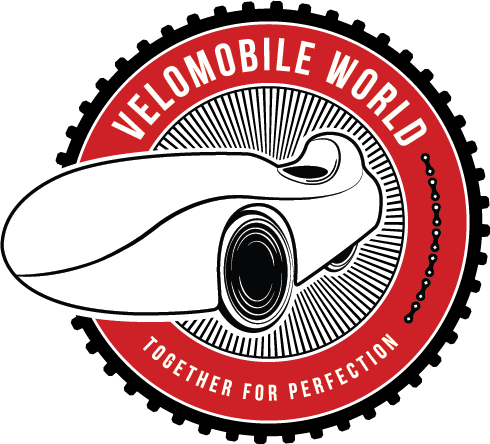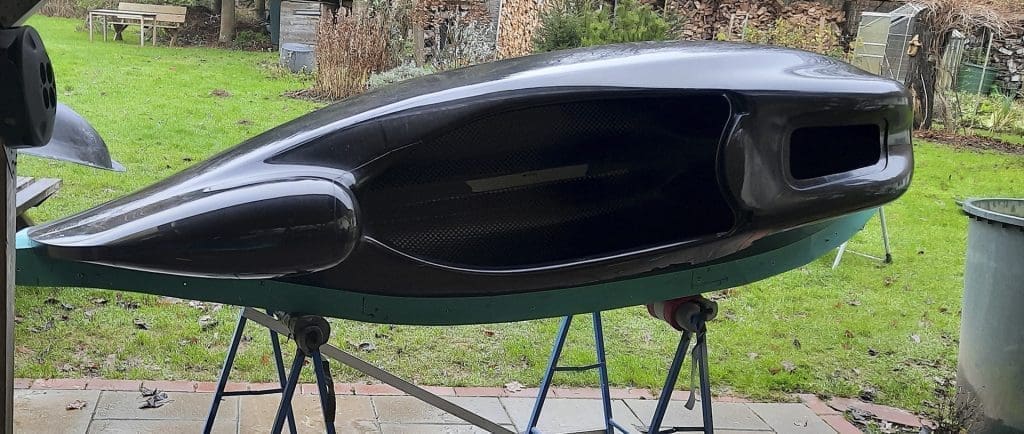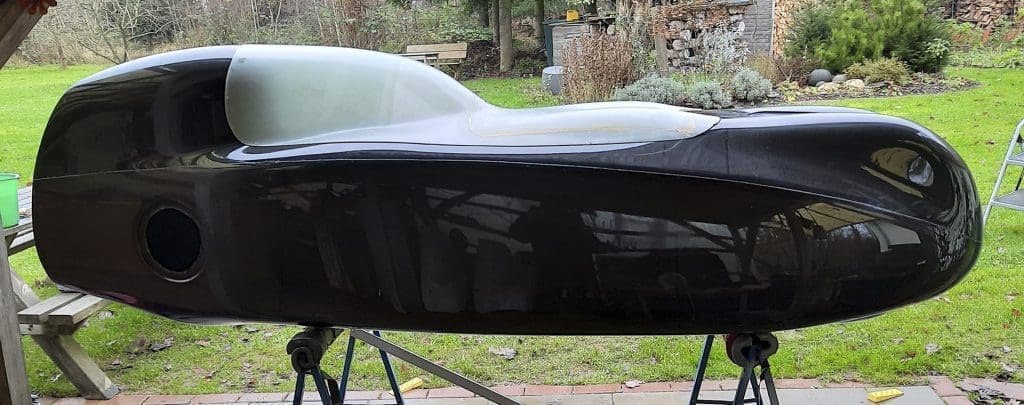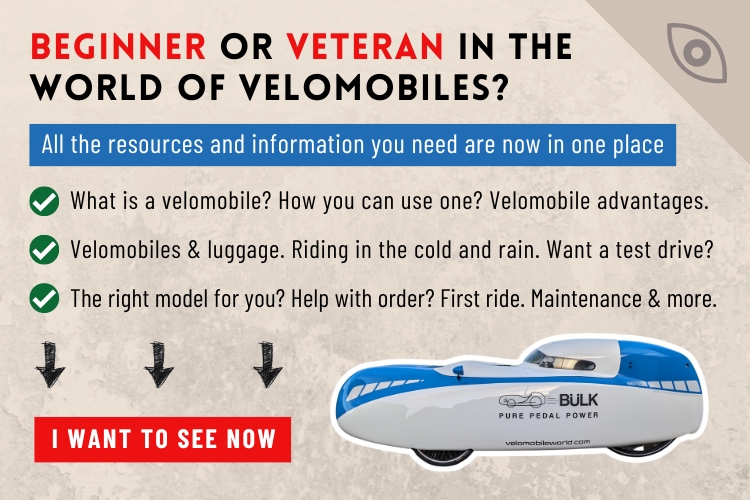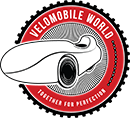1. What was the aim of this development?
The aim was to build a velomobile that made as few compromises as possible in terms of aerodynamic efficiency, driving pleasure and suitability for everyday use. At the same time, it had to be extremely compact (257 cm long, 84 cm high and 70 cm wide), but also allow shoulder widths of 60 cm and heights of up to 200 cm. With a 28 inch (622) rear wheel.
2. The philosophy of the Bülk-MK1
To reconcile these objectives, a range of competing objective functions had to be weighted and reconciled. In the Bülk MK1 we have tried to create an overall composition that is as coherent as possible and that optimally implements all the essential requirements of a modern velomobile.
Tasks in the area of the increasingly urgent mobility turnaround play a role, as do suitability for everyday use, driving pleasure, dynamic and aerodynamic efficiency, safety and sustainability.
What is meant by competing objective functions? What is meant here are those properties of a velomobile that are expected by customers today, but which lead to collisions and contradictions when implemented in a vehicle concept:
✓ For example, the demand for a lot of storage space collides with aerodynamic efficiency, as do the space requirements of tall and heavy drivers.
✓ Powerful thighs need space in the front wheelhouse, but that limits the steering angle on the other side.
✓ Demands for compactness of the vehicle contradict the desire to be able to accommodate drivers as tall as possible in the vehicle.
✓ In order to achieve aerodynamic efficiency, the vehicle’s air-friction surface must be as small as possible, while at the same time the vehicle must not converge too bluntly at the rear in order to avoid wake turbulence.
✓ Low weight competes with demands for high stability and security.
✓ Velomobile drivers want very good weather protection, but at the same time want to have as much contact with the environment as possible; experience the environment with their senses.
✓ Stability in crosswinds must not be at the expense of aerodynamic efficiency.
There is a whole range of other antagonisms that need to be brought together in an overall composition when constructing a forward-looking velomobile.
That’s why we saw it as a challenge to make use of the unproductive dead spaces between these antagonists or to productively overcome them, or to resolve the contradictions themselves in the process.
It is of course clear that there are no objective criteria for the respective weighting of claims and each consumer has their own individual preferences.
Nevertheless, there are large intersections. Eggert and I have many years of experience in velomobile development and marketing, and with the Bülk MK1 we think we have created a velomobile that takes these intersections into account in a good way.
3. Here are the main points in detail:
a) Compactness and modularity
b) Efficiency and aerodynamics
c) Driving stability and driving dynamics
d) Suitability for everyday use
e) Security
f) Specifications
a) Compactness and modularity
– The vehicle design is optimally tailored to the space requirements of the pedalling driver. A hybrid of teardrop and laminar design has proven to be appropriate to accommodate the rider’s space requirements at shoulder and arm height. As a result, the vehicle can be very short.
– A very low head rest area, which extends down to the rear wheel housing, allows even very tall drivers a good view and sufficient space under the hood. This opens up a very wide adjustment range for small to large drivers:
– The Bülk MK1 can be adjusted to different driver sizes between 150 -200 cm in just a few minutes: With the adapter module for the head rest area, it can be easily adjusted to the driver using Velcro. The leg length can be adjusted without tools via the seat rail with 5 positions or, in extreme cases, also by shifting the bottom bracket slide. The space required for the knees and head is determined by selecting the appropriate hood (3 sizes: flat, medium and high knee protuberances) and an optional module for the heel protuberances.
With this modularity, an exact adjustment to very different driver sizes, leg or seat giants can be made within a very short time. Even the cross-sectional area of the vehicle can easily be adapted to the driver.
This means extreme flexibility in terms of usability in families, partnerships or communities.
In addition, this also increases the resale value, since the potential customer group is very large. Dealers have the advantage that they only need one demonstration vehicle.
b) Efficiency and aerodynamics
The new and compact design of the Bülk MK1 is based on our many years of experience in velomobile construction and on measurements in the wind tunnel. A semi-laminar design with a strongly flattened and short bow as well as an overall great compactness has been found to be optimal. The Bülk MK1 redefines the optimal interaction of cross-sectional area, air-friction surface and space requirement of the driver. This compactness also enables a new weight-stiffness ratio.
The space lines for heel and foot tips are adapted to a narrow bottom bracket size. This achieves a very efficient transmission of power to the pedals with a small cross-sectional area at the same time.
With the new design, outstanding overall efficiency is possible.
Efficiency of the drive:
The drive of the Bülk is extremely stiff. The bearing points of the carbon mono swing arm are stable due to the overall construction. The rear wheel house is connected to the head rest area of the body and thus prevents movement of the swingarm- bearing .
The front-boom has a cross-section of 50 x 50 mm² and is arranged in a Y-design: it gets its rigidity from a vertical beam between the transverse tunnel of the wheelhouse and the top of the body. This also prevents vertical movements of the deflection roller.
c) Driving stability and driving dynamics
The floor pan between the front and rear axles has been optimized for the driver’s center of gravity to be as low as possible. This is where space is usually wasted with velomobiles. The Bülk MK1 also pushes the limit in this respect. This also creates a higher interior and space for taller drivers.
The overall aerodynamic design is designed for high stability in cross winds. Due to the strongly rounded and flattened bow, the pressure point and center of gravity of the vehicle are so close together that the vehicle automatically stabilizes in cross winds. The buoyancy in cross winds is specifically prevented by the shape and the floor pan causes suction towards the ground in cross winds. This defuses dangerous situations during strong wind and gusts.
d) Suitability for everyday use
✓ The flat seating position and wide seat allow for long and relaxed rides as the rider’s weight is distributed over a large area. The butt muscles are relieved and the head can rest on the softly padded headrest. This is how travelling is fun. The seat can be removed with a flick of the wrist and used to transport luggage into the house or work.
✓ Rainproof: the hoods all have a circumferential overlapping water edge and effective water drainage in the hinge area. Rain, even downpours, are no longer a threat and make the vehicle a comfortable retreat from the cold and wet. This means that this velomobile can fully demonstrate its year-round suitability.
✓ The huge manhole:
– The Büllk MK1 has a huge entry opening for various reasons. This gives the Bülk another unique selling point. At traffic lights or when driving up steep hills, the hood can be raised with one hand and give the driver massive ventilation. Even with the bonnet raised, the driver still has a view of the road ahead, because the semicircular hinge area opens up a comfortable view to the front when the hood is raised. This is an invaluable advantage, especially on longer, very steep mountain climbs. In this driving situation, visibility for vehicles behind is also significantly increased by the raised bonnet and improves safety.
– The large entry opening makes it easier to get in and out, as well as for rescue or an emergency exit. In addition, the coaming is very low. This makes getting out of the car even easier and also allows manual reversing on the road.
– After removing the seat, it is very easy to get to the luggage or the technology.
– The hood can be dismantled in two easy steps. Then the driving fun in convertible mode beckons: you can only experience it in this way in the Bülk MK1. Whether alone or in a group: in this mode, the Bülk MK1 enables an incredibly sensual and intoxicating perception of the environment while still retaining its high-speed properties. A challenge to all undisguised but slow tricycles.
– In convertible mode you can experience the surroundings together with your companion and exchange ideas. The huge exit opening largely eliminates the separation from the environment without losing the security and protection of the velomobile body. Interesting encounters with people are pre-programmed in this mode…
– The entry opening, which is pulled far forward, also allows access to the luggage compartments that are optionally mounted in the front. Another unique selling point.
– Due to the low-lying coaming, you can also drive in the so-called double manta position; sometimes a welcome change.
✓ Unmatched forward visibility:
– The front of the vehicle is kept as flat as possible and has a distinctive indentation between the protuberances for the tips of the feet. This provides a very good view of the road in front of the vehicle, which is an invaluable advantage when maneuvering or on bad roads.
– Even small drivers can sit low (favorable center of gravity) and retain a very good view to the front).
✓ Compactness:
– With a length of only 257 cm, a height of 84 cm and a width of 70 cm, the vehicle is one of the most compact velomobiles. This makes it easier to transport by car or train and to park in general. The narrow width allows for a high level of flexibility narrow passages (e.g. doors, traffic gaps, barriers) Due to its compactness, the vehicle can be built light and very stiff.
✓ Ventilation options:
– The Bülk MK1 is equipped with a whole range of ventilation options:
– There is a trumpet-shaped opening at the pressure point of the bow, which provides good ventilation for the driver’s legs and torso via the front frame.
– The hoods feature an adjustable Naca inlet just in front of the rider’s face, allowing for powerful cooling of the head. This means that you can usually ride with the visor closed, which results in better aerodynamics.
– Optionally, the front service flap can also be exchanged for a Naca module.
✓ Packable foam hood:
– The Büllk MK1 comes standard with a combination foam hood (carbon cover + foam hood). This can be stowed in the vehicle and thus enables flexible adjustment to changing weather conditions while driving.
✓ Luggage compartment:
– Due to the optional luggage compartments in the front and the relatively wide rear part of the vehicle, there is enough luggage space to be able to go on extended camping holidays.
✓ Simple service:
– With its 2 service flaps (rear derailleur flap, flap in the bow above) and the huge access hatch with quick seat removal, the Bülk MK1 offers excellent access to the internal technology. So you can easily make adjustments to the bottom bracket or the crankset while sitting in the Bülk (on the driving roller) without having to get out in between.
e) Security
The entire design of the Bülk took place under the primacy of the greatest possible safety for the driver. 16 years of experience in velomobile construction and the systematic evaluation of accidents flowed into the design. In detail:
✓ The carbon body is secured with safety- inserts between the carbon layers to prevent splitting and tearing in the event of a crash.
✓ Safety in the event of a frontal crash: With its T-design, the front frame is constructed in such a way that it cannot shift towards the driver. This not only protects the rider, but also dissipates a lot of energy by allowing the front part of the frame to be compressed without being pushed backwards. The flat seating position and the coaming effectively prevent the driver from sitting up and the upper body from accelerating forward.
✓ Safety in the event of a rear impact:
– In the event of a rear-end collision, the driver’s head is effectively protected by the thick foam padding on the headrest surface.
– The seat is not suspended at the top in the Bülk. This prevents the thrust of a rear-end collision from going towards the driver’s neck.
– In the back area, the stable seat with bars protects the driver’s spine. The shearing forces of a rear-end collision are distributed over the entire seat and passed on to the driver. The seat support in the shoulder area is provided by hard foam panels and forms another buffer in which energy is dissipated.
✓ Side flap:
– Thanks to the flat seating position and the padded, protective coaming, the driver remains safe in the vehicle if it rolls sideways. The high overhang of the hood effectively protects the driver’s head.
✓ Insensitive to side winds:
– Every detail of the aerodynamic design is designed for maximum driving stability in cross winds. This is an essential safety feature for velomobiles.
With all these features, the Bülk MK1 gets a top position in terms of safety.
f) Specifications:
– Length: 257cm
– Width at front wheels: 70 cm
– Width at shoulders: 60 cm
– Height: 84 cm + optional light module
– Weight: 22-23.5 kg depending on equipment
– Frame section: 50 x 50 mm²
– CW value: 0.12 to 0.13, depending on tire width
– Front wheels: 20 inches
– Rear wheel: 28 inch (622)
*All information without guarantee and subject to technical changes
